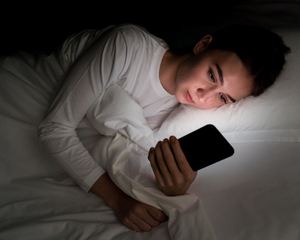How Light and Screen Time Affect Your Sleep and Headache Patterns
Body
Ever find yourself lying in bed, wide awake, even though you’re exhausted? Maybe your phone’s still glowing inches from your face. Maybe your head's already starting to throb. If that sounds familiar, you’re not imagining things, your screen might be partly to blame.
In fact, headaches are linked to lack of sleep, and the light you’re exposed to, especially from screens, messes more with your body than you’d expect. This post isn’t just about avoiding late-night scrolling. It’s about understanding how light, tech, and sleep all connect, and how you can make some surprisingly simple shifts to start feeling better.
Let’s break it down.
Why Blue Light Isn’t as Innocent as It Seems
It’s easy to assume that your phone is nothing more than a harmless bedtime distraction. You scroll, maybe watch a few videos, reply to messages, and eventually doze off. But that glowing screen, especially if it’s right in front of your face, might be telling your brain to stay awake.
The culprit? Blue light. It’s a type of light your phone, tablet, and laptop all give off. And your brain reacts to it as if it’s sunlight.
That means when you check your emails at 11 p.m., your brain thinks it’s morning. It holds off on releasing melatonin, the hormone that helps you wind down and fall asleep. The longer you delay that signal, the more your natural rhythm gets thrown off.
And it doesn’t stop there. Less melatonin means lighter, broken sleep. Which means you wake up groggy and less equipped to handle stress. Over time, that leads to headaches.
We don’t think of light as a trigger, but maybe we should.
Do Screens Really Make Your Head Hurt?
You ever sit in front of your screen too long and feel that weird pressure behind your eyes? Kind of like your head’s telling you it needs a break, but you keep going anyway? That’s digital eye strain. It’s not rare anymore. In fact, it’s one of those things you don’t notice until it creeps up and stays.
It’s more than just sore eyes, too. Most of us lean forward when we’re on our phones or laptops. That hunched-over thing we all do? It builds tension in the neck and shoulders, and that tension has a funny way of turning into a headache you carry all day.
For some, it’s even worse. People who get migraines may find that too much screen time acts as a trigger. Flickering lights, high contrast, and too much visual stimulation can all play a role.
The thing is that screens are part of life now. Most of us can’t avoid them entirely. But knowing how they impact your body is the first step in making smarter choices.
The Vicious Cycle — Poor Sleep and Daily Headaches
So, what happens when your sleep gets interrupted night after night? You feel off. Your body’s tired, but your brain’s foggy and irritable. That’s when the headaches start creeping in.
Let’s talk about that cycle. Lack of sleep makes your body more sensitive to pain. So, a mild discomfort turns into a pounding headache. You wake up feeling drained, and then you try to push through the day with coffee and a tight schedule. That only adds more strain, which means more pain.
At night, your body is still buzzing from all that stress, and falling asleep becomes even harder. It just keeps repeating.
This is where headaches are linked to lack of sleep. Because your body never really gets a reset. Without that deep, consistent rest, your brain doesn’t get the downtime it needs to recover from the day’s tension. It stays stuck in alert mode.
If you’ve ever had that kind of week, where each day blends into the next and your head won’t quit throbbing, you know exactly what this cycle feels like.
Morning Light vs. Evening Light; Timing Matters
Here’s something most people don’t think about: the kind of light you’re exposed to isn’t just about brightness. It’s about timing.
Morning light, especially natural sunlight, helps set your internal body clock. When you step outside early in the day, your brain gets the message: it’s time to wake up, focus, move. That early light helps regulate melatonin for later, so when night rolls around, you’re ready to wind down naturally.
Now flip that. Bright artificial light at 10 p.m.? That confuses your system. Your brain thinks it’s still go-time, and melatonin gets delayed. So even when you lie in bed, your body isn’t on the same page.
It’s not always easy to avoid artificial light, especially if you’re working late or winding down with a show. But if you can shift your routine, even just a little, it can make a difference. Start the day with sunlight and end the day in dimmer lighting. Your sleep (and your head) might just be thankful.
What can you actually do about all this?
Tips That Actually Work
Here are some real, doable changes that don’t require a total lifestyle overhaul:
- Use night mode or blue light filters on your devices in the evening. Most phones and computers have this built-in now.
- Try the 20-20-20 rule when working: every 20 minutes, look at something 20 feet away for at least 20 seconds.
- Avoid screens at least one hour before bed. Yes, it’s tough. But that one hour can change how you sleep.
- Get blackout curtains or use amber light bulbs at night. Your bedroom should feel like it’s meant for rest.
- Keep your phone off the bed. If you need to charge it, put it across the room. That one shift can stop a lot of late-night doomscrolling.
It’s hard to break habits, especially when tech is everywhere. You might forget. You might fall back into old routines. That’s fine. Change isn’t about being perfect. It’s about trying again, little by little.
You might not notice the difference overnight. But after a week or two? You just might start sleeping better. And your headaches? They might ease up too.
The connection between your sleep, your screens, and your head pain isn’t some mystery. It’s real, and it’s affecting more of us than we realize. It’s not just stress causing those headaches. Poor sleep plays a big role, and screen time at night often makes things worse.
But here’s the good news: you don’t need to toss out all your devices or become a monk to fix it. A few small shifts; dimming your lights at night, setting screen boundaries, and getting morning sunlight, can help reset your body’s rhythm.










Comments